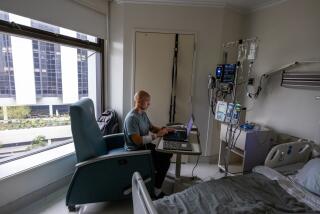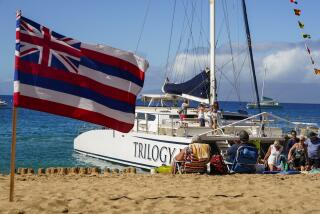Philippine typhoon survivors get a warm, even festive welcome
PASAY, Philippines — Volunteers packed the grandstand at Villamor Air Base, eyes trained on the airfield for the next flight to arrive from islands battered by Typhoon Haiyan.
As a C-130 cargo plane rolled into view, they surged forward to form a cheering, clapping guard of honor for the exhausted people disgorged from the aircraft.
The display, which is repeated about six times a day, is part of an outpouring of support for victims of Haiyan, whose ferocity stunned a nation all too familiar with natural disasters. Filipinos call it the spirit of bayanihan, or communal action, a cherished value in times of hardship in this Western Pacific island nation.
Every day, more people turn up at the base on the outskirts of Manila, the capital, eager to help, said Col. Miguel Okol, a Philippine air force spokesman.
A businesswoman was looking for a housekeeper, so she drove over one afternoon to see whether she could hire one of the new arrivals. A group of cheerful nuns waited nearby, ready to extend prayers and a sympathetic ear.
They were surrounded by tents offering bowls of steaming soup, free cellphone calls, clothing, haircuts, massages and stress “debriefings.” The festive scene was more county fair than national calamity.
“We were so touched,” said Lorna Montes, 41, who arrived Tuesday on a plane from Guiuan with her 43-year-old cousin, Criselda Burjal. “We thought when we came down the plane, there would be no one.… We weren’t expecting this warm welcome.”
The women are from the tiny island of Homonhon, off Samar island, where Guiuan is located. Before the storm hit, they sought shelter at the island’s hospital. But howling wind shattered the windows and ripped off part of the roof.
“We were running all over the place, trying to find a place to hide,” Burjal said. “The floor was all glass. Children were crying, screaming.”
Miraculously, no one died on the island, they said. But the typhoon ravaged their homes, coconut groves and fishing boats, knocked out power and communications, and left the community cut off from the rest of the country for more than a week.
When help finally arrived on a U.S. helicopter, the women begged for a lift. They were taken to the airport in Guiuan to wait for military transport to Villamor. It was the first time either of them had been in the air, and Montes, for one, was terrified. The cousins laughed about it later.
In the midst of the joyful scene, families of some of the 1,600 people still missing sat tensely at the top of the grandstand, hoping that one of the arriving planes might be carrying their loved ones.
Sarah de la Rosa last spoke with her sister, Veronica Justimano, days before the typhoon.
“I am worried because I don’t have any contact with my sister,” said De la Rosa, 52. “She doesn’t reply [to] my texts. We don’t know if she is alive or …”
She couldn’t bring herself to say the word.
When a plane landed, De la Rosa jumped up, scanning the passengers for a familiar face. But there was no sign of her sister. Defeated, she sat back down and wailed: “Until when will I be waiting?”
The storm, known by Filipinos as Yolanda, was one of the worst typhoons to ever make landfall. It left more than 4,000 people dead, 18,500 injured and 4 million displaced, according to the latest government count.
Villamor serves as a hub for the international relief efforts. Military cargo planes leave with food, water and other supplies, and return with as many people as can be crammed into the seats and on the floors.
Thousands have waited for days in the punishing sun and rain for a chance to escape the disaster zone. They arrive looking dazed and weather-beaten, carrying little more than a backpack or plastic shopping bag. Most of their possessions were swept away when Haiyan ripped through the central Philippines on Nov. 8.
One woman was in tears as she walked through the applauding throng.
“Thank you, thank you,” a man repeated, as bottles of water, apples and a pack lunch were thrust into his hands.
Each family is assigned a red-bibbed marshal, who whisks them through the reception process. Staff from the Department of Social Welfare and Development register the families and figure out what kind of help they need.
Most have relatives in the area, said Edna Sacedor, the lead social worker. But for those who don’t, the city of Pasay has made space available at a school for tents serving up to 100 families. Ambulances are on hand to ferry anyone needing medical attention to nearby hospitals.
A play area has been set up to entertain the children while their parents chat with counselors, with plenty of books, games and stuffed toys to choose from. The caregivers study the children’s drawings for signs of trauma, but say most of them are turning out sunny pictures of houses and flowers.
“They are very resilient,” said Aiza Caparas-Tabayoyong, a family counselor. “The colors are still bright. … We might cry before they do.”
She recalled a 7-year-old boy who picked out toys for each of his two brothers and a sister, seemingly unable to take in that they had all died.
In the next tent, a group of women had set up a soup kitchen, offering local favorites such as chicken adobo, a hearty stew flavored with vinegar and soy sauce.
“We realize that they haven’t eaten in a while, and they want something familiar,” said Rambie Lim, a 34-year-old textile merchandiser who was in charge of the day’s meal. “We believe in our family that there is a lot of love in food, so that is what we want to share.”
At the nearby Salvation Army tent, 10-year-old Arlyn Mae Saliwan stared wide-eyed at stacks of donated clothing. Shyly, she picked out a T-shirt for the uncle who agreed to take her in along with her mother and sister. The girl’s father and brother had stayed behind in Guiuan to rebuild the family home.
“We have nothing left,” said Arlyn’s 23-year-old sister, Abigail. “We have no house. We have no food. That’s the reason we decided to leave, but we’ll be back soon.”
When the evacuees have what they need, area volunteers using personal vehicles will drive them to their families.
Montes and Burjal waited for a lift surrounded by bags of food, clothing and sleeping mats. “We’ve been shopping,” Burjal joked merrily.
A volunteer handed the women ice cream cones. They were looking forward to a shower and their first good night’s sleep since the typhoon struck.
They had no immediate plans to return to their island.
“I’m worried about what we are going to eat after the relief” distributions end, Montes explained. “We want to be employed here and send money back to the island.”
Their names were called and they were bundled into a car driven by two sisters with time to spare and a desire to do more than watch the tragedy unfold on their TV sets.
“We’ve been crying; now we’re excited,” Burjal said. “A new life!”
More to Read
Start your day right
Sign up for Essential California for news, features and recommendations from the L.A. Times and beyond in your inbox six days a week.
You may occasionally receive promotional content from the Los Angeles Times.





